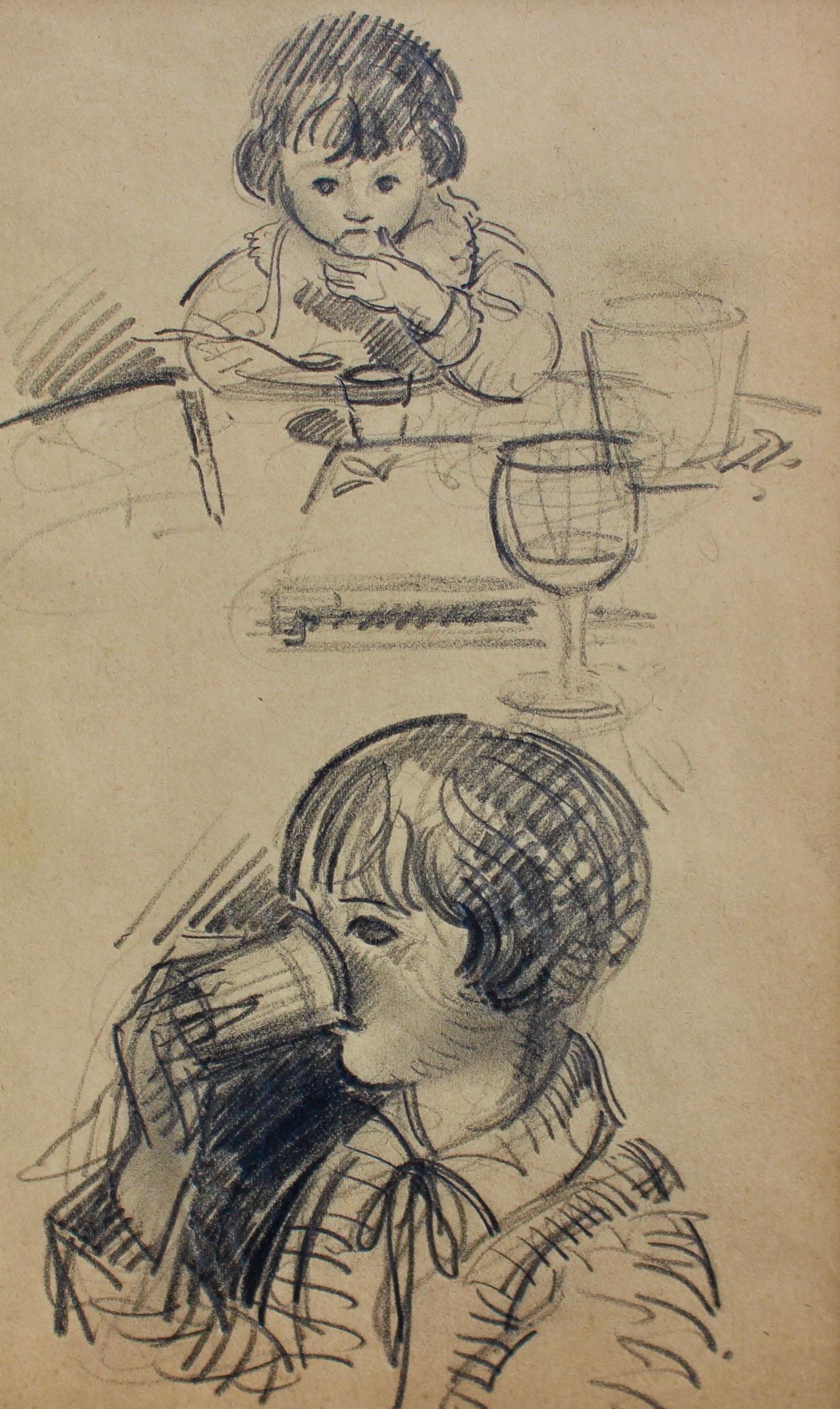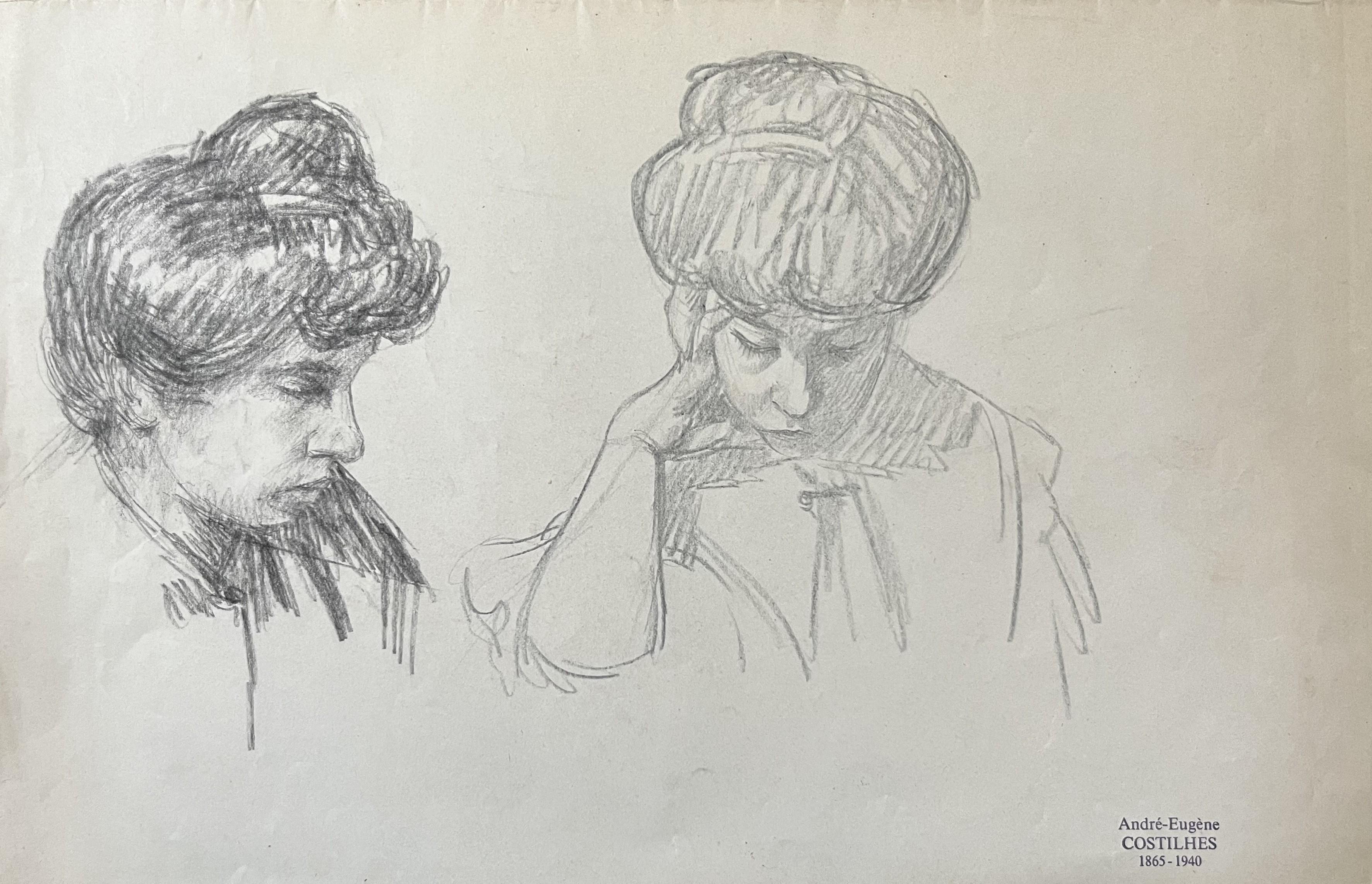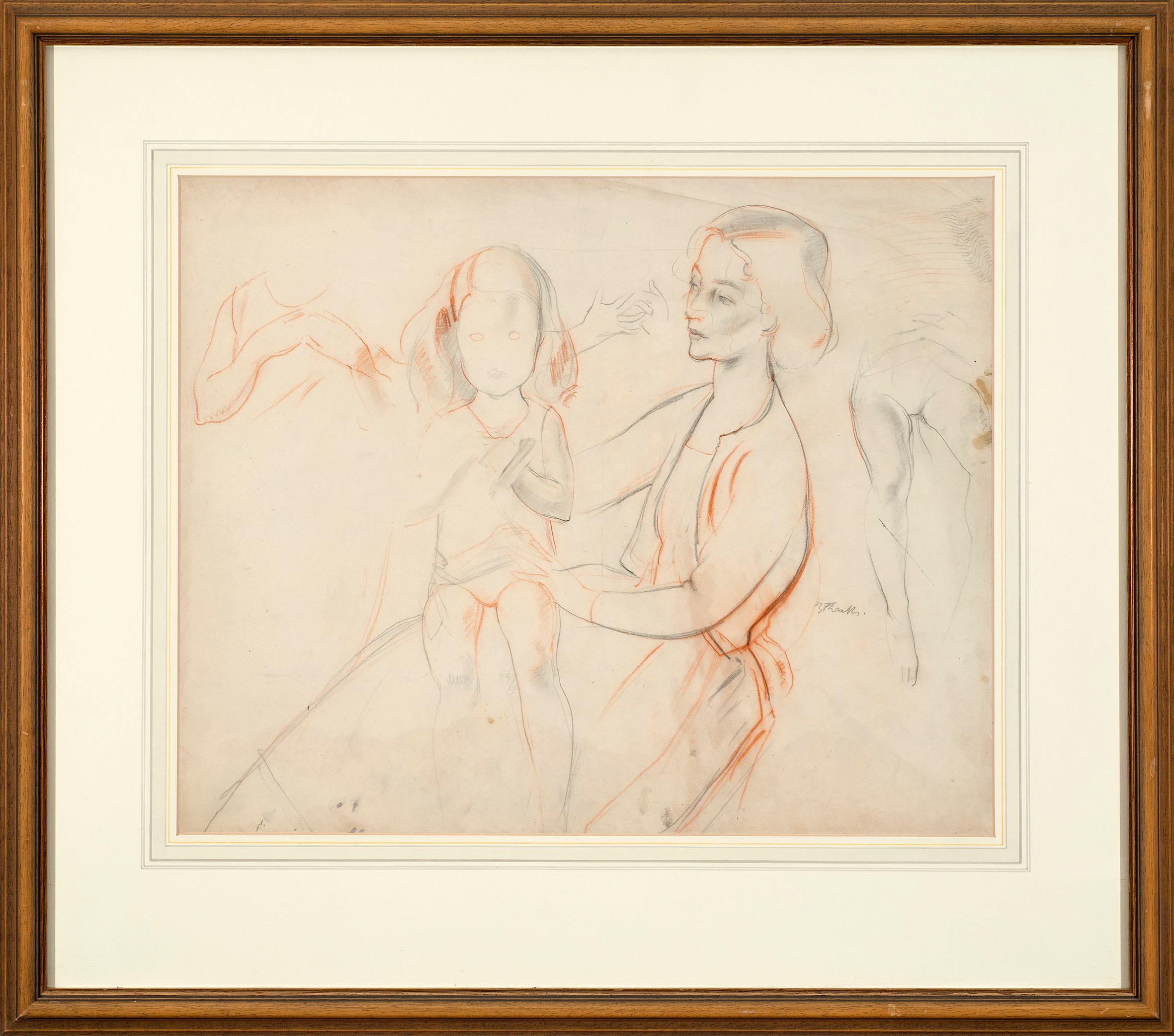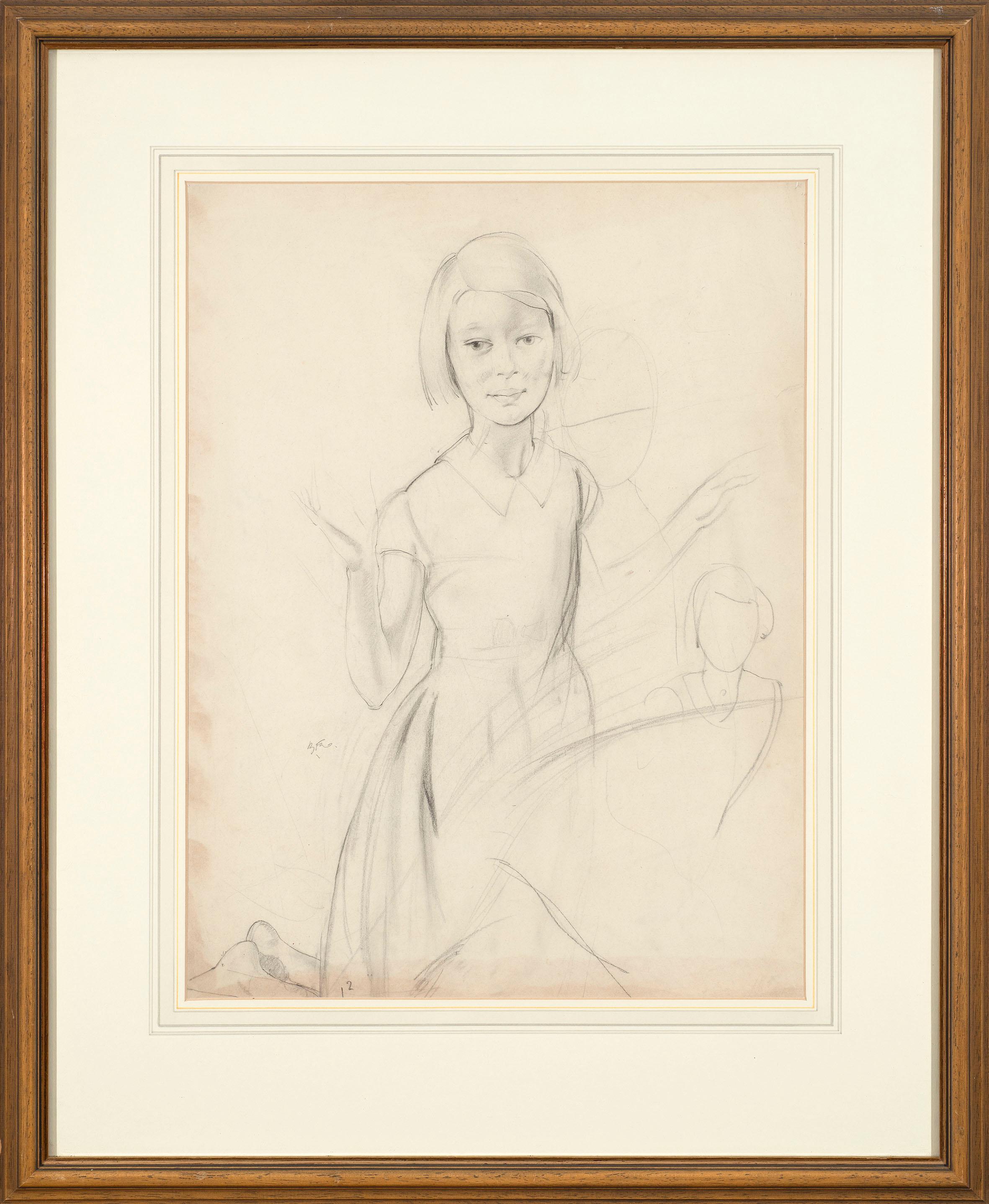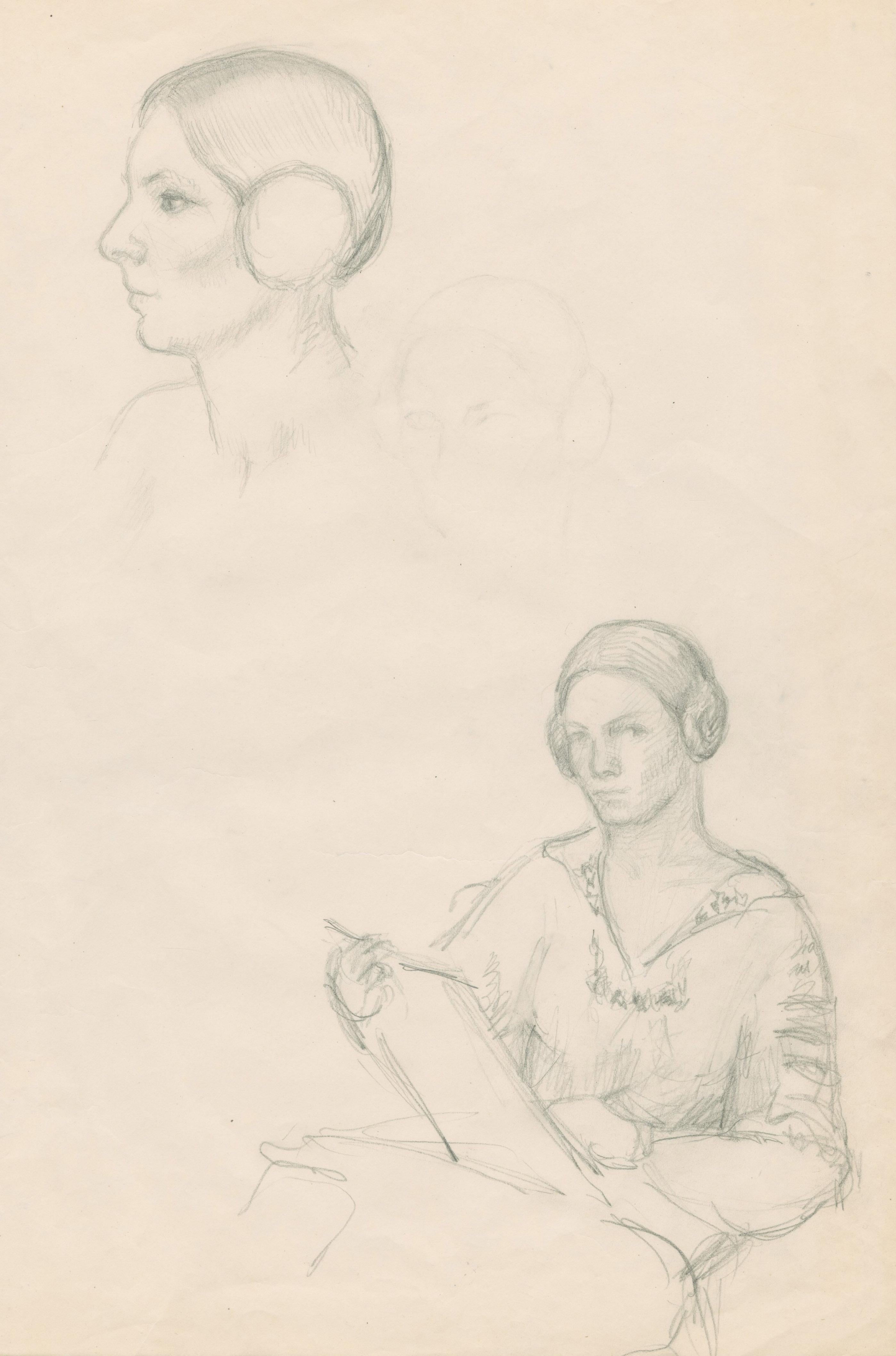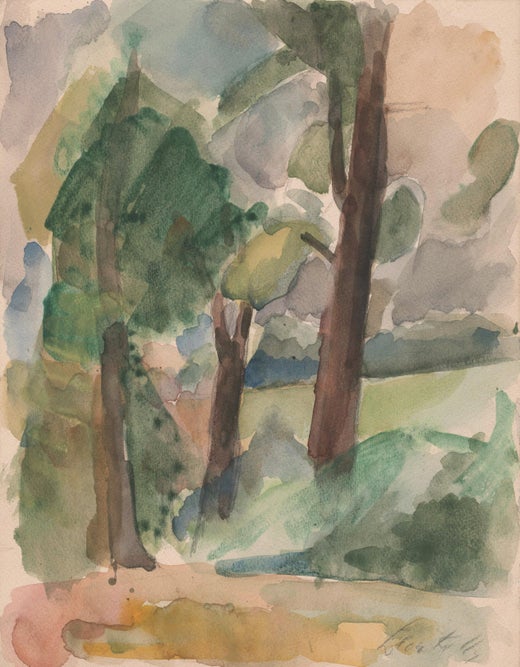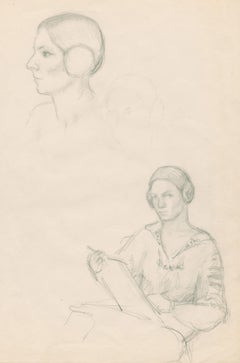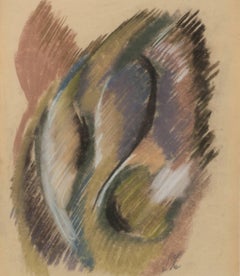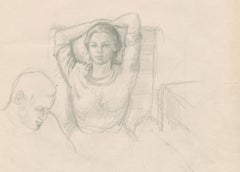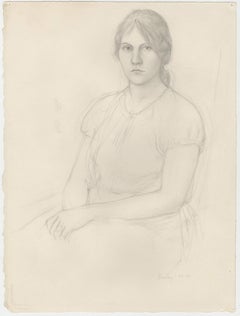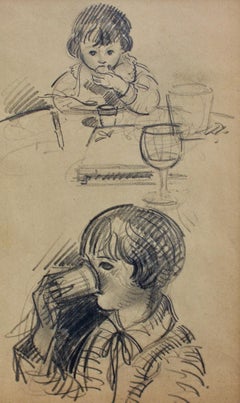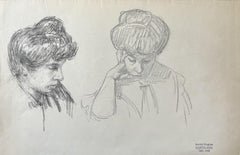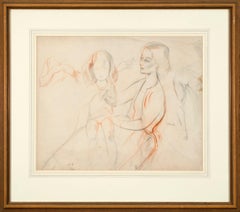Items Similar to Two Studies of Henriette (Head of the artist's wife & The Artist's wife writing
Want more images or videos?
Request additional images or videos from the seller
1 of 7
Leon KellyTwo Studies of Henriette (Head of the artist's wife & The Artist's wife writing1928-1930
1928-1930
$3,000
£2,277.97
€2,605.03
CA$4,191.44
A$4,661.79
CHF 2,434.24
MX$56,729.03
NOK 31,088.99
SEK 29,155.99
DKK 19,442.34
Shipping
Retrieving quote...The 1stDibs Promise:
Authenticity Guarantee,
Money-Back Guarantee,
24-Hour Cancellation
About the Item
Two Studies of Henriette (Left: Head of the artist's wife, Right: The Artist's wife writing a letter)
Watercolor and graphite on paper, 1928-1930
Signed in pencil lower right (see photo)
Image/sheet size: 9 3/8 x 11 inches
Condition: Excellent
Colors fresh and unfaded
Provenance: Estate of the artist
The Orange Chicken
The influence of Renoir is seen in the study of the head of Henriette, and the strong influence of Bonnard is seen in the vignette of Henriette writing a letter.
Kelly was influenced by the art collection of this patron Albert Barnes, the famous collector
Leon Kelly (From Wikipedia, the free encyclopedia)
Leon Kelly (October 21, 1901 – June 28, 1982) was an American artist born in Philadelphia, PA. He is most well known for his contributions to American Surrealism, but his work also encompassed styles such as Cubism, Social Realism, and Abstraction. Reclusive by nature, a character trait that became more exaggerated in the 1940s and later, Kelly's work reflects his determination not to be limited by the trends of his time. His large output of paintings is complemented by a prolific number of drawings that span his career of 50 years. Some of the collections where his work is represented are: The Metropolitan Museum in New York, The Whitney Museum of American Art, the Museum of Modern Art, the Philadelphia Museum of Art, and Boston Public Library.
Biography
Kelly was born in 1901 at home at 1533 Newkirk Street, Philadelphia, PA. He was the only child of Elizabeth (née Stevenson) and Pantaleon L. Kelly. The family resided in Philadelphia where Pantaleon and two of his cousins owned Kelly Brothers, a successful tailoring business. The prosperity of the firm enabled his father to purchase a 144-acre farm in Bucks County PA in 1902, which he named "Rural Retreat" It was here that Pantaleon took Leon to spend every weekend away from the pressures of business and from the disappointments in his failing marriage. Idyllic and peaceful memories of the farm stayed with Leon and embued his work with a love of nature that emerged later in the Lunar Series, in Return and Departure, and in the insect imagery of his Surrealist work. "If anything," he once said,"I am a Pantheist and see a spirit in everything, the grass, the rocks, everything."
At thirteen, Leon left school and began private painting lessons with Albert Jean Adolphe, a teacher at the School of Industrial Art (now the University of the Arts) in Philadelphia. He learned technique by copying the works of the old masters and visiting the Philadelphia Zoo, where he would draw animals. Drawings done in 1916 and 1917 of elephants, snakes and antelope, as well as copies of old master paintings by Holbein and Michelangelo, heralded an impressive emerging talent. In 1917, he studied sculpture with Alexander Portnoff but his studies came to an abrupt halt with the start of World War I. Being too young to enlist, he joined the Quartermaster Corp at the Army Depot in Philadelphia, where he served for more than a year loading ships with supplies and, along with other artists, working on drawings for camouflage.
By 1920, the family's fortunes drastically changed. His father's business had failed due to the introduction of ready made clothing and his marriage, unhappy from the beginning, dissolved. Broken by circumstance Pantaleon left Philadelphia to begin a wandering existence looking for work leaving Leon to support his mother and grandmother. He found a job in 1920 at the Freihofer Baking Company where he worked nights for the next four years. Under these circumstances Leon continued to develop his skills in drawing and painting and learned of the revolutionary developments in art that were taking place in Paris.
During the day he was granted permission to study anatomy at the Philadelphia School of Osteopathy where he dissected a cadaver and perfected his knowledge of the human figure. He also met and studied etching with Earl Horter, a well known illustrator, who had amassed a significant collection of modern art which included work by Brancusi, Matisse, and Cubist works by Picasso and Braque. Among the artists around Horter was Arthur Carles, a charismatic and controversial painter who taught at the Pennsylvania Academy of Fine Arts. Leon enrolled in the Academy in 1922, becoming what Carles described as, "his best student".
In the next three years Leon work ranged from academic studies of plaster casts, to pointillism, to landscapes of Fairmount Park in Philadelphia, as well as a series of pastels showing influences from Matisse to Picasso. Clearly influenced by Earl Horter's collection and Arthur Carles he mastered analytical cubism in works such as The Three Pears, 1923 and 1925 experimented with Purism in Moon Behind the Italian House. In 1925 Kelly was awarded a Cresson Scholarship and on June 14 he left for Europe.
Paris
The first trip to Europe lasted for approximately three and a half months and introduced Kelly to a culture and place where he felt he belonged. Though he returned to the Academy in the Fall, he left for Europe again a few months later to begin a four-year stay in Paris. He moved into an apartment at 19 rue Daguerre in Paris and began an existence intellectually rich but in creature comforts, very poor. "I kept a cinderblock over the drain in the kitchen sink to keep the rats out of the apartment" he once explained. He frequented the cafes making acquaintances with Henry Miller, James Joyce and the critic Félix Fénéon as well as others. His days were split between copying old master paintings in the Louvre and pursuing modernist ideas that were swirling through the work of all the artists around him. The Lake, 1926 and Interior of the Studio, 1927, now in the Newark Museum.
Patrons during this time were the police official Leon Zamaran, a collector of Courbets, Lautrecs and others, who began collecting Kelly's work. Another was Alfred Barnes of the Barnes Collection in Philadelphia.
In 1929 Kelly married a young French woman, Henriette D'Erfurth. She appears frequently in paintings and drawings done between 1928 and the early 1930s.
Philadelphia
The stock market crash of 1929 made it impossible to continue living in Paris and Kelly and Henriette returned to Philadelphia in 1930. He rented a studio on Thompson Street and began working and participating in shows in the city's galleries. Work from 1930 to 1940 showed continuing influences and experimentation with the themes and techniques acquired in Paris as well as a brief foray into Social Realism. The Little Gallery of Contemporary Art purchased the Absinthe Drinker in 1931 and in 1932 exhibited Judgement of Paris, 1932, an ambitious painting with a classical theme. In October 1934, "Interior of a Slaughter House" and several other works were included in "Second Regional Exhibition of Painting and Prints by Philadelphia Artists" at the Whitney Museum in New York.
Kelly joined the Philadelphia Public Works of Art Project and worked on sketches for a mural destined for the School Administration Building. While some sketches survived, one is in the Metropolitan, the mural is lost. The harsh financial conditions of Kelly's life continued and by the late 1930s, Henriette, who spoke no English and whose only companionship outside the home was Helen Lloyd Horter (who spoke French), returned to France permanently When his divorce was finalized, Kelly began seeing Helen Lloyd Horter, a Philadelphia painter and a fellow student at the Academy and who was now the ex-wife of Earl Horter. In 1941 they married.
Kelly continued to work in his studio on Brandywine Street in Philadelphia teaching small classes to gain some income. Kelly's study of the masters in the Louvre collection resulted in great admiration for the Renaissance painter Leonardo Da Vinci. His influence is evident in Kelly's notebooks of this time which are full of drawings for World War II battlements and weaponry which echo DaVinci's drawings for the mechanisms of war. He also shared Leonardo's fascination with science and the underlying dynamics of how things work. His interest of the nervous system and sensory aspects of human anatomy would later come important components of his abstract figures of the 1950s and '60s.
For the complete article on Kelly, see Wikipedia
In the 1930s, he exhibited in Philadelphia and was connected with the avant-garde group aligned to the colorist Arthur Beecher Carles. Albert Barnes, the collector and patron of the arts, admired Kelly’s work and helped finance him through some difficult times. Julian Levy, a prominent art dealer in New York also took note of Kelly and showed his work in his gallery during the 1940s and 1950s.
- Creator:Leon Kelly (1901-1982, American)
- Creation Year:1928-1930
- Dimensions:Height: 9.38 in (23.83 cm)Width: 11 in (27.94 cm)
- Medium:
- Movement & Style:
- Period:
- Condition:
- Gallery Location:Fairlawn, OH
- Reference Number:Seller: FA120861stDibs: LU1409055202
Leon Kelly
Leon Kelly, born in 1901, studied at the Pennsylvania Academy of the Fine Arts, Philadelphia. Awarded a traveling scholarship from that institution in 1924, he studied in Paris, France at the Grande Chaumiere. Other teachers included Arthur B. Carles, Jean Auguste Adolphe, Earl Horter and Alexandre Portinoff. Essentially a Surrealist painter, Kelly did wide-ranging work that went from painterly to meticulous Surrealism, Cezanne-inspired watercolors, and Cubist painting. In the 1940s, Julian Levy, the Surrealist dealer, handled Kelly's work in New York City. Kelly also exhibited at the Pennsylvania Academy of the Fine Art Annuals (1933-34, 1939-46, 1966); Corcoran Gallery Biennials, Washington, D.C. (three times from 1935-47); Art Institute of Chicago, Illinois; had a 1965 retrospective exhibition at the International Gallery, Baltimore, Maryland; Long Beach, New Jersey (1968); Richard Feigen Gallery, Chicago, Illinois (1968, 1970); Newark Museum, New Jersey (1969); and the Whitney Museum of American Art, New York. Kelly's paintings are in the collections of three New York city museums, including the Metropolitan Museum of Art; Whitney Museum of American Art; and Museum of Modern Art; as well as Yale University Art Gallery, New Haven, Connecticut; Wadsworth Atheneum, Hartford, Connecticut; Pennsylvania Academy of the Fine Arts, Philadelphia; Cantor Arts Center, Stanford University, Palo Alto, California; Sara Roby Foundation Collection at the Smithsonian Institution, Washington, D.C.; Smith College Museum of Art, Northampton, Massachusetts; Sheldon Memorial Art Gallery, Lincoln, Nebraska; Newark Museum, New Jersey; and the Tel Aviv Museum, Israel.
About the Seller
5.0
Recognized Seller
These prestigious sellers are industry leaders and represent the highest echelon for item quality and design.
Gold Seller
Premium sellers maintaining a 4.3+ rating and 24-hour response times
Established in 1978
1stDibs seller since 2013
799 sales on 1stDibs
Typical response time: <1 hour
Associations
International Fine Print Dealers Association
- ShippingRetrieving quote...Shipping from: Fairlawn, OH
- Return Policy
Authenticity Guarantee
In the unlikely event there’s an issue with an item’s authenticity, contact us within 1 year for a full refund. DetailsMoney-Back Guarantee
If your item is not as described, is damaged in transit, or does not arrive, contact us within 7 days for a full refund. Details24-Hour Cancellation
You have a 24-hour grace period in which to reconsider your purchase, with no questions asked.Vetted Professional Sellers
Our world-class sellers must adhere to strict standards for service and quality, maintaining the integrity of our listings.Price-Match Guarantee
If you find that a seller listed the same item for a lower price elsewhere, we’ll match it.Trusted Global Delivery
Our best-in-class carrier network provides specialized shipping options worldwide, including custom delivery.More From This Seller
View AllSelf Portrait sketching with Vignette in Profile
Located in Fairlawn, OH
Self Portrait sketching with Vignette in Profile
Graphite on thin wove paper, c. 1940's
Unsigned
Condition: Small nicks in the right margin, not affecting the image
Sheet size: 14 1/2 x 10 inches
Provenance: Paul Cadmus
Jon F. Anderson (1937-2018)
Born in Hoboken, New Jersey, Margaret Hoening (1906–1998) was a painter and an etcher perhaps best known for her
photographs as part of the PaJaMa photography collective. After attending Smith College, she settled in New York, where
she pursued formal artistic training at the Art Students League. There, she met the artist couple Paul Cadmus and Jared
French. In 1937, she married French, fifteen years her junior, who had spent the previous decade with Cadmus. The trio
formed a tight bond, with Cadmus and French continuing their relationship.
Born in Hoboken, New Jersey, Margaret Hoening (1906–1998) was a painter and an etcher perhaps best known for her
photographs as part of the PaJaMa photography collective. After attending Smith College, she settled in New York, where
she pursued formal artistic training at the Art Students League. There, she met the artist couple Paul Cadmus and Jared
French. In 1937, she married French, fifteen years her junior, who had spent the previous decade with Cadmus. The trio
formed a tight bond, with Cadmus and French continuing their relationship. Together, the three formed PaJaMa (a mashup of their first names, Paul, Jared, and Margaret). Using Hoening’s Leica, they captured themselves, their artist friends,
and members of the gay community posing in artful tableaux on the beaches of Fire Island, Provincetown, and Nantucket
over the following eight years. Those captured by their camera include the photographer George Platt Lynes; Cadmus’s
sister and artist Fidelma; artist Bernard Perlin; and Monroe Wheeler, director of exhibitions at the Museum of Modern Art,
among others. Though she produced few canvases, Hoening’s paintings demonstrate the influences of French and Cadmus,
particularly with her adoption of the time-intensive, traditional medium of egg tempera that they championed.
In the 1940s, the Frenches’ social circle continued to expand. They befriended the British author E.M. Forster, who stayed
with them on his first trip to New York in 1947, spending a few days with them in Provincetown, and visiting them again
in 1949. When Cadmus began a relationship with the young artist George Tooker in 1944, the trio became a foursome,
with Tooker regularly vacationing with the group and appearing in PaJaMa’s photographs...
Category
1940s American Modern Portrait Drawings and Watercolors
Materials
Graphite
Untitled
By Leon Kelly
Located in Fairlawn, OH
Untitled
Pastel on paper, 1922
Initialed lower right (see photo)
Exhibited: Francis Nauman, Leon Kelly: Draftsman Extraordinaire, New York, April 4 - May 23, 2014.
Condition: Excell...
Category
20th Century American Modern Abstract Drawings and Watercolors
Materials
Pastel
$4,000
Self Portrait with Arms Over Head, vignette on Paul Cadmus on left
Located in Fairlawn, OH
Self Portrait with Arms Over Head, vignette on Paul Cadmus on left
Graphite drawing on thin wove paper, c. 1940's
Unsigned
Provenance: Paull Cadmus
Jon F. Anderson (1937-2018)
Condition:
Sheet size: 15 x 10 1/4 inches
Born in Hoboken, New Jersey, Margaret Hoening (1906–1998) was a painter and an etcher perhaps best known for her
photographs as part of the PaJaMa photography collective. After attending Smith College, she settled in New York, where
she pursued formal artistic training at the Art Students League. There, she met the artist couple Paul Cadmus and Jared
French. In 1937, she married French, fifteen years her junior, who had spent the previous decade with Cadmus. The trio
formed a tight bond, with Cadmus and French continuing their relationship.
Born in Hoboken, New Jersey, Margaret Hoening (1906–1998) was a painter and an etcher perhaps best known for her
photographs as part of the PaJaMa photography collective. After attending Smith College, she settled in New York, where
she pursued formal artistic training at the Art Students League. There, she met the artist couple Paul Cadmus and Jared
French. In 1937, she married French, fifteen years her junior, who had spent the previous decade with Cadmus. The trio
formed a tight bond, with Cadmus and French continuing their relationship. Together, the three formed PaJaMa (a mashup of their first names, Paul, Jared, and Margaret). Using Hoening’s Leica, they captured themselves, their artist friends,
and members of the gay community posing in artful tableaux on the beaches of Fire Island, Provincetown, and Nantucket
over the following eight years. Those captured by their camera include the photographer George Platt Lynes; Cadmus’s
sister and artist Fidelma; artist Bernard Perlin; and Monroe Wheeler, director of exhibitions at the Museum of Modern Art,
among others. Though she produced few canvases, Hoening’s paintings demonstrate the influences of French and Cadmus,
particularly with her adoption of the time-intensive, traditional medium of egg tempera that they championed.
In the 1940s, the Frenches’ social circle continued to expand. They befriended the British author E.M. Forster, who stayed
with them on his first trip to New York in 1947, spending a few days with them in Provincetown, and visiting them again
in 1949. When Cadmus began a relationship with the young artist George Tooker in 1944, the trio became a foursome,
with Tooker regularly vacationing with the group and appearing in PaJaMa’s photographs...
Category
1940s American Modern Portrait Drawings and Watercolors
Materials
Graphite
Untitled (Seated Young Woman)
Located in Fairlawn, OH
Untitled (Seated Young Woman)
Graphite on Veritable Papier d'Arches wove paper, 1970
Signed and dated lower right (see photo)
Condition: Excellent
Image/sheet size: 15 x 11 1/4 inch...
Category
1970s American Realist Figurative Drawings and Watercolors
Materials
Graphite
Seated Female Nude (two studies)
By Pierre Saint-Ange Poterlet
Located in Fairlawn, OH
Recling Female Nude
Charcoal on tan paper
Signed: Poterlet bottom center (see photo)
Provenance:
Alfred Barrion, Lugt 76 lower right recto (see photo)
Eric G. Carlson, 1985
Very good...
Category
19th Century Romantic Nude Drawings and Watercolors
Materials
Charcoal
Preparatory drawing for Figure Composition, Carmel (CA.)
By E. Ambrose Webster
Located in Fairlawn, OH
Preparatory drawing for Figure Composition, Carmel (CA)
Graphite on paper, 1931
Signed with the artist's initial "W" lower right corner (see photo)...
Category
1930s American Modern Nude Drawings and Watercolors
Materials
Graphite
You May Also Like
Portrait of Two Sisters
By Guillaume Dulac
Located in London, GB
'Portrait of Two Sisters', pencil on art paper, by French artist, Guillaume Dulac (circa 1920s). An artist known for his exquisite drawings - many are sketches for his larger oil pai...
Category
1920s Portrait Drawings and Watercolors
Materials
Paper, Pencil
$602 Sale Price
20% Off
André Eugène Costilhes (1865-1940) Two studies of women, drawing
By André Eugène Costilhes
Located in Paris, FR
André Eugène Costilhes (1865-1940)
Two studies of women
bears the stamp of the studio of André Eugène Costilhes in the lower right-hand corner
pencil on paper
23 x 36 cm
In good ...
Category
Early 1900s Symbolist Portrait Drawings and Watercolors
Materials
Pencil
Figurative Study of a Women and Man
By Emile Lejeune
Located in Houston, TX
Figurative study of a woman in her undergarments and elderly men's profile. The work is stamped by the artist. The paper is not framed.
Many others are available. Please inquire to buy the entire collection.
Artist Biography: Emile Lejeune...
Category
Late 19th Century Naturalistic Figurative Drawings and Watercolors
Materials
Graphite
Study for Mr and Mrs R. H. Butler and Their Daughters
Located in Maidenhead, GB
Bernard Fleetwood-Walker RA RWS (1893-1965)
Study for Mr and Mrs R. H. Butler and Their Daughters, c. 1932
Graphite and coloured graphite on paper, mounted to card
Signed centre right
42.6 x 53 cm.; (within frame) 66.7 x 75.7 cm.
Provenance:
The artist’s studio, 1965 (no. 521);
Private Collection, United Kingdom.
Dated to c. 1932, the present drawing belongs to a series of preparatory studies for Mr and Mrs R. H. Butler and Their Daughters (1932), a large family composition...
Category
1930s Post-Impressionist Portrait Drawings and Watercolors
Materials
Watercolor
Study for Mr and Mrs R. H. Butler and Their Daughters
Located in Maidenhead, GB
Bernard Fleetwood-Walker RA RWS (1893-1965)
Study for Mr and Mrs R. H. Butler and Their Daughters, c. 1932
Graphite on paper, mounted to card
Signed centre left
53 x 42.8 cm.; (within frame) 77.6 x 62.8 cm.
Provenance:
The artist’s studio, 1965 (no. 523);
Private Collection, United Kingdom.
Dated to c. 1932, the present drawing belongs to a series of preparatory studies for Mr and Mrs R. H. Butler and Their Daughters (1932), a large family composition...
Category
1930s Post-Impressionist Portrait Drawings and Watercolors
Materials
Watercolor
Two Figures - Original Drawing by Henri Epstein - Early 20th Century
Located in Roma, IT
Two Figures is an Original Pencil Drawing realized by Henri Epstein (1892-1944).
Good condition on a yellowed paper, included a white cardboard (35x51 cm).
Hand-signed by the artist on the lower right corner.
Henri Epstein born in Lódz ( Russian Empire ) on January 14 , 1891 where theJune 20 , 18922 , 3 and died in deportation to Auschwitz ( Third Reich...
Category
Early 20th Century Modern Interior Drawings and Watercolors
Materials
Pencil
More Ways To Browse
English Renaissance Painting
Kelly 50
Memories Of Surrealism
American Revolutionary War
Renoir Drawings
Two Head Snake
Cast Plaster Head
Michelangelo Drawings
Da Vinci Drawings
French Chicken Painting
Picasso Head Sculpture
Elephant Head Sculpture
James Joyce
Poor Things
Head Of A Woman Picasso
Plaster Louvre
Picasso Mother And Child
Judgement Of Paris
